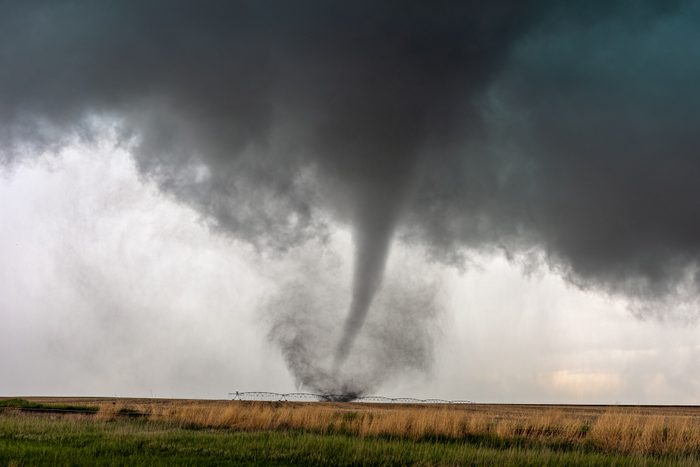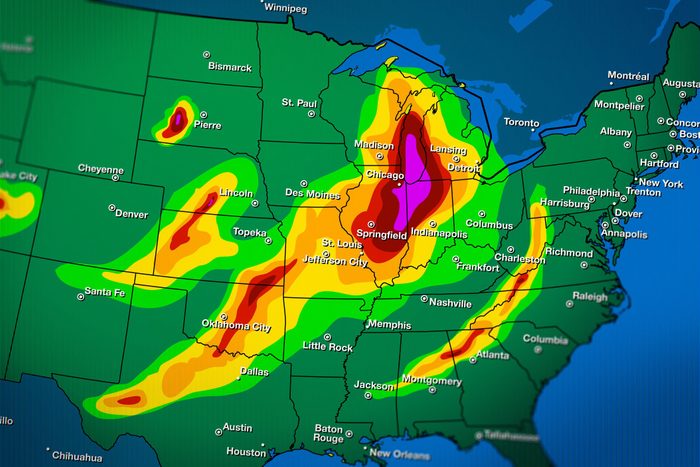Learn how to prepare for a tornado so you're ready when the next one strikes

How to Prepare for a Tornado, According to Experts


Know the terms
Do you know the difference between a tornado watch and a tornado warning? Study up before the next thunderstorm hits. If a tornado watch is issued, you should prepare to hunker down, because the weather may deteriorate quickly. Watch areas typically cover a wide area, and the watch may apply to multiple counties or even several states at the same time, Fox says.
A tornado warning, on the other hand, means a tornado has been spotted or Doppler radar has confirmed a tornado is present or could form at any time. In other words, “danger is imminent,” Fox says. “A warning should trigger you to immediately seek shelter and take action to keep you and your family safe.”
When National Oceanic and Atmospheric Administration (NOAA) meteorologists issue a tornado watch or warning, you will receive a notification via alerts on your phone. You should also tune in to your local TV or radio news station for the latest information.

Put together an emergency kit
Keeping an emergency supply kit in your car and home is another essential way you can prepare for a tornado, before it or any natural disaster strikes. Whether you build your own home emergency kit or purchase one online, it should include supplies like a first-aid kit, water bottles, nonperishable food, copies of important documents, prescription medication and cash, Fox says.
The Centers for Disease Control and Prevention (CDC) recommends stocking up on enough supplies to last at least three days, just in case emergency services can’t reach you immediately after the storm. Keep your emergency kit in a spot that is easily accessible, so you can grab it before taking shelter.

Identify where to seek shelter
If you live in one of the states most prone to natural disasters like tornadoes, scope out the safe spots in your house to hide in case of an emergency. In fact, do this no matter where you live, because tornadoes have happened in all 50 states.
The safest place to seek shelter in your home is an underground storm cellar or basement. If you do not have an underground shelter, go to a small interior windowless room on the lowest floor of your house, such as a closet or center hallway. If you have an interior bathroom with no windows, you can get in the bathtub, though it’s a weather myth that the bathroom is safer than other small, windowless rooms. Cover your head and neck.
“The goal is to put as many walls between you and the outside world as possible, to prevent injury from flying debris,” Fox says.

Know what to do if you’re on the road
If you are driving when a tornado warning is issued and are not near shelter, Fox advises pulling over and parking. With your seatbelt on and engine running, put your head down below the windows and cover your head with your hands and a blanket to protect yourself from glass and other flying debris.
You can also find a ditch or other low-lying area that will protect you from debris, then lie down and cover your head with your hands. Avoid areas with trees, and do not seek shelter underneath a highway overpass or bridge, where strong winds could create a wind tunnel and carry debris toward you at a very high speed, Fox says.

Download weather alert apps
You should have at least two ways to receive weather and emergency alerts. “Advanced warning and swift action can mean the difference between life and death” in a tornado, Fox says. Here are three proven options.
- Tune in to your local television station.
- Listen to a battery-powered NOAA weather radio.
- Install weather apps that send alerts to your phone.
Fox suggests downloading the free Red Cross Emergency app for real-time weather alerts, nearby Red Cross shelter locations and expert advice on tornadoes. You can get it by visiting the Apple or Google Play app stores or the Red Cross website, or by texting GETEMERGENCY to 90999.

Create and practice your emergency plan
Preparing for the worst is one of the best ways to stay safe. That includes creating and practicing an emergency plan to teach household members, including children, how to prepare for a tornado and other weather-related events.
Make sure to share key information on tornado safety, including:
- Signs of a tornado
- What tornado watches and warnings are
- The tornado warning system in your area
- The emergency dismissal policy for your child’s school
- The best places in your home to take shelter, and multiple ways to access them
- Where the fire extinguisher and first-aid kit are located, and how to use them
- What to do once the tornado has passed
Once you have a plan, the CDC advises conducting drills to practice responding to a tornado warning, including taking shelter and locating first-aid and other emergency equipment. And don’t forget about your pets. You should keep them close during severe weather, as well as include them in your practice sessions.

Check on your neighbors
In addition to creating an emergency plan for your own household, take the time to confirm that elderly or disabled neighbors have ways to receive emergency information, and know where they might seek shelter during a tornado. It’s just part of being a good neighbor.
“If mobility is a concern, they may need additional assistance from friends and family who are close by,” Fox says. The CDC recommends writing down their needs, limitations, capabilities and medications, and asking them for a spare key to their home or directions to find a key. Keep the list and spare key in your emergency kit.

Monitor the sky
Sometimes, a tornado will strike too quickly for an alert to be sent out, or “you may not hear [outdoor tornado sirens] while inside your home,” Fox says. That’s why it’s important to stay vigilant during bad weather. When thunderstorms hit your area, start watching the sky for warning signs that a tornado may be forming or approaching. A dark or green-colored sky, as well as large, dark and low-flying clouds, could be red flags, according to the CDC.

Move or secure household items
After a tornado watch or warning is issued, the CDC recommends taking swift action to reduce hazards both inside and outside your home. For example, try to move heavy furniture like chairs and beds away from windows or other glass like mirrors, as well as placing heavy or large objects on lower shelves. You should also consider the items you have outside that could be picked up by strong winds and cause damage—such as your car or outdoor seating—and work to move or secure them the best you can, Fox says.

Steps to take after the tornado has passed
Even after the winds die down, danger can still linger. According to the American Red Cross and the U.S. Department of Homeland Security, here’s what you should do and how you can help after a tornado passes:
Stay put until it’s safe outside
Wait for official confirmation that the tornado threat has passed. Tornadoes can strike in multiple waves, so monitor a weather radio, local alerts or a reliable weather app before leaving your shelter.
Check for injuries
Assess yourself and the people around you for injuries. Administer basic first aid if needed, but avoid moving seriously injured individuals unless there’s an immediate risk like fire or structural collapse.
Watch for hazards
Step cautiously—debris, downed power lines, exposed nails, broken glass or gas leaks can all pose serious threats. If you smell gas, hear hissing or suspect a leak, evacuate the area and notify authorities.
Don’t use your phone unless it’s an emergency
You must keep phone lines free for emergency use. Texting is often more reliable than calling in disaster zones.
Stay tuned for updates
Continue to follow local news or NOAA weather radio for emergency instructions, recovery resources and updates about additional weather risks.
FAQs
Do things get calm before a tornado?
The wind may die down just before a tornado forms, but not always. Pay attention to weather alerts, not the wind speed, to know when to seek shelter.
Where is the strongest part of a tornado?
The strongest winds in a tornado happen just outside the vortex. Much like a skater who pulls their arms in to spin faster, air pulled into the funnel gets stronger and stronger the tighter it spins.
What was the worst tornado in history?
The Tri-State Tornado on March 18, 1925, was the deadliest in U.S. history. The storm affected people in Indiana, Illinois and Missouri. Almost 2000 people were injured, and 700 were killed.
About the expert
|
Why trust us
At Reader’s Digest, we’re committed to producing high-quality content by writers with expertise and experience in their field in consultation with relevant, qualified experts. We rely on reputable primary sources, including government and professional organizations and academic institutions as well as our writers’ personal experiences where appropriate. We verify all facts and data, back them with credible sourcing and revisit them over time to ensure they remain accurate and up to date. Read more about our team, our contributors and our editorial policies.
Sources:
- Stephanie Fox, spokesperson for the American Red Cross
- National Weather Service: “2024 Tornado Activity Reached Near-Historic Levels Across the U.S.”
- CDC: “Preparing for a Tornado”
- NOAA National Severe Storm Laboratory: “Severe Weather 101”
- Ready.gov: “Steps to take after a tornado”
- American Red Cross: “Tornado Safety”
- National Weather Service: “Tornado Definition”




















